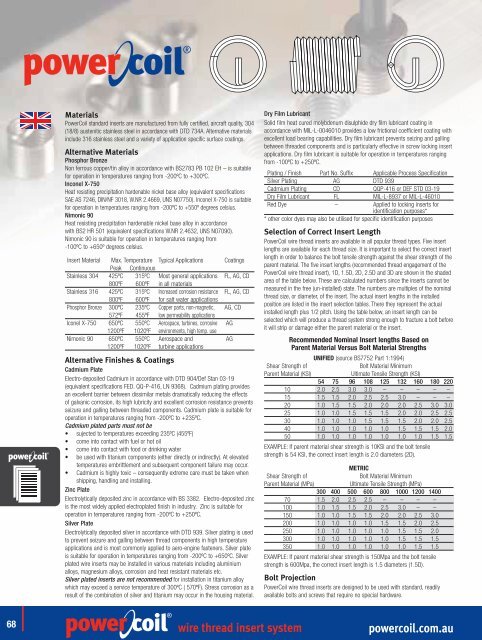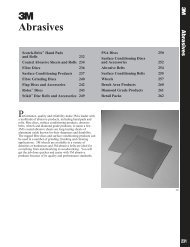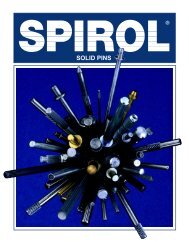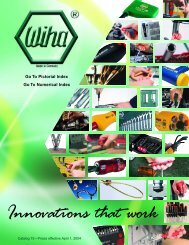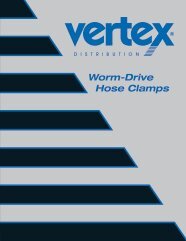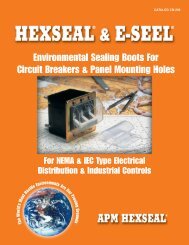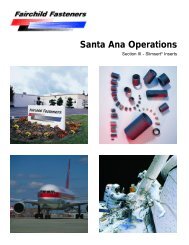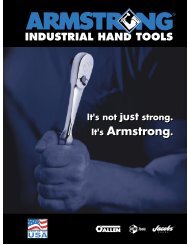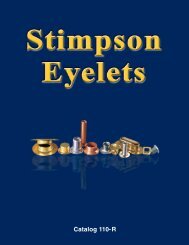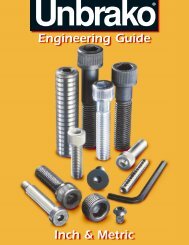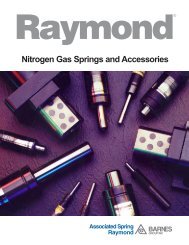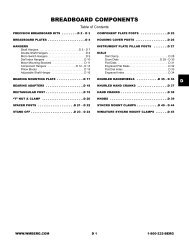You also want an ePaper? Increase the reach of your titles
YUMPU automatically turns print PDFs into web optimized ePapers that Google loves.
®®Materials<strong>PowerCoil</strong> standard <strong>insert</strong>s are manufactured from fully certified, aircraft quality, 304(18/8) austenitic stainless steel in accordance with DTD 734A. Alternative materialsinclude 316 stainless steel and a variety of application specific surface coatings.Alternative MaterialsPhosphor BronzeNon ferrous copper/tin alloy in accordance with BS2783 PB 102 EH – is suitablefor operation in temperatures ranging from -200ºC to +300ºC.Inconel X-750Heat resisting precipitation hardenable nickel base alloy (equivalent specificationsSAE AS 7246, DIN/NF 3018, W.NR 2.4669, UNS N07750). Inconel X-750 is suitablefor operation in temperatures ranging from -200ºC to +550º degrees celsius.Nimonic 90Heat resisting precipitation hardenable nickel base alloy in accordancewith BS2 HR 501 (equivalent specifications W.NR 2.4632, UNS N07090).Nimonic 90 is suitable for operation in temperatures ranging from-100ºC to +650º degrees celsius.Insert Material Max. Temperature Typical Applications CoatingsPeak ContinuousStainless 304 425ºC 315ºC Most general applications FL, AG, CD800ºF 600ºF in all materialsStainless 316 425ºC 315ºC Increased corrosion resistance FL, AG, CD800ºF 600ºF for salt water applicationsPhosphor Bronze 300ºC 235ºC Copper parts, non-magnetic, AG, CD572ºF 455ºF low permeability applicationsIconel X-750 650ºC 550ºC Aerospace, turbines, corrosive AG1200ºF 1020ºF environments, high temp. useNimonic 90 650ºC 550ºC Aerospace and AG1200ºF 1020ºF turbine applicationsAlternative Finishes & CoatingsCadmium PlateElectro-deposited Cadmium in accordance with DTD 904/Def Stan 03-19(equivalent specifications FED. QQ-P-416, LN 9368). Cadmium plating providesan excellent barrier between dissimilar metals dramatically reducing the effectsof galvanic corrosion, its high lubricity and excellent corrosion resistance preventsseizure and galling between <strong>thread</strong>ed components. Cadmium plate is suitable foroperation in temperatures ranging from -200ºC to +235ºC.Cadmium plated parts must not be• sujected to temperatures exceeding 235ºC (455ºF)• come into contact with fuel or hot oil• come into contact with food or drinking water• be used with titanium components (either directly or indirectly). At elevatedtemperatures embrittlement and subsequent component failure may occur.• Cadmium is highly toxic – consequently extreme care must be taken whenshipping, handling and installing.Zinc PlateElectrolytically deposited zinc in accordance with BS 3382. Electro-deposited zincis the most widely applied electroplated finish in industry. Zinc is suitable foroperation in temperatures ranging from -200ºC to +250ºC.Silver PlateElectrolytically deposited silver in accordance with DTD 939. Silver plating is usedto prevent seizure and galling between <strong>thread</strong> components in high temperatureapplications and is most commonly applied to aero-engine fasteners. Silver plateis suitable for operation in temperatures ranging from -200ºC to +650ºC. Silverplated <strong>wire</strong> <strong>insert</strong>s may be installed in various materials including aluminiumalloys, magnesium alloys, corrosion and heat resistant materials etc.Silver plated <strong>insert</strong>s are not recommended for installation in titanium alloywhich may exceed a service temperature of 300ºC ( 570ºF). Stress corrosion as aresult of the combination of silver and titanium may occur in the housing material.Dry Film LubricantSolid film heat cured molybdenum disulphide dry film lubricant coating inaccordance with MIL-L-0046010 provides a low frictional coefficient coating withexcellent load bearing capabilities. Dry film lubricant prevents seizing and gallingbetween <strong>thread</strong>ed components and is particularly effective in screw locking <strong>insert</strong>applications. Dry film lubricant is suitable for operation in temperatures rangingfrom -100ºC to +250ºC.Plating / Finish Part No. Suffix Applicable Process SpecificationSilver Plating AG DTD 939Cadmium Plating CD QQP-416 or DEF STD 03-19Dry Film Lubricant FL MIL-L-8937 or MIL-L-46010Red Dye – Applied to locking <strong>insert</strong>s foridentification purposes** other color dyes may also be utilised for specific identification purposesSelection of Correct Insert Length<strong>PowerCoil</strong> <strong>wire</strong> <strong>thread</strong> <strong>insert</strong>s are available in all popular <strong>thread</strong> types. Five <strong>insert</strong>lengths are available for each <strong>thread</strong> size. It is important to select the correct <strong>insert</strong>length in order to balance the bolt tensile strength against the shear strength of theparent material. The five <strong>insert</strong> lengths (recommended <strong>thread</strong> engagement of the<strong>PowerCoil</strong> <strong>wire</strong> <strong>thread</strong> <strong>insert</strong>), 1D, 1.5D, 2D, 2.5D and 3D are shown in the shadedarea of the table below. These are calculated numbers since the <strong>insert</strong>s cannot bemeasured in the free (un-installed) state. The numbers are multiples of the nominal<strong>thread</strong> size, or diameter, of the <strong>insert</strong>. The actual <strong>insert</strong> lengths in the installedposition are listed in the <strong>insert</strong> selection tables. There they represent the actualinstalled length plus 1/2 pitch. Using the table below, an <strong>insert</strong> length can beselected which will produce a <strong>thread</strong> <strong>system</strong> strong enough to fracture a bolt beforeit will strip or damage either the parent material or the <strong>insert</strong>.Recommended Nominal Insert lengths Based onParent Material Versus Bolt Material StrengthsUNIFIED (source BS7752 Part 1:1994)Shear Strength ofParent Material (KSI)Bolt Material MinimumUltimate Tensile Strength (KSI)54 75 96 108 125 132 160 180 22010 2.0 2.5 3.0 3.0 – – – – –15 1.5 1.5 2.0 2.5 2.5 3.0 – – –20 1.0 1.5 1.5 2.0 2.0 2.0 2.5 3.0 3.025 1.0 1.0 1.5 1.5 1.5 2.0 2.0 2.5 2.530 1.0 1.0 1.0 1.5 1.5 1.5 2.0 2.0 2.540 1.0 1.0 1.0 1.0 1.0 1.5 1.5 1.5 2.050 1.0 1.0 1.0 1.0 1.0 1.0 1.0 1.5 1.5EXAMPLE: If parent material shear strength is 10KSI and the bolt tensilestrength is 54 KSI, the correct <strong>insert</strong> length is 2.0 diameters (2D).METRICShear Strength ofBolt Material MinimumParent Material (MPa)Ultimate Tensile Strength (MPa)300 400 500 600 800 1000 1200 140070 1.5 2.0 2.5 2.5 – – – –100 1.0 1.5 1.5 2.0 2.5 3.0 – –150 1.0 1.0 1.5 1.5 2.0 2.0 2.5 3.0200 1.0 1.0 1.0 1.0 1.5 1.5 2.0 2.5250 1.0 1.0 1.0 1.0 1.0 1.5 1.5 2.0300 1.0 1.0 1.0 1.0 1.0 1.5 1.5 1.5350 1.0 1.0 1.0 1.0 1.0 1.0 1.5 1.5EXAMPLE: If parent material shear strength is 150Mpa and the bolt tensilestrength is 600Mpa, the correct <strong>insert</strong> length is 1.5 diameters (1.5D).Bolt Projection<strong>PowerCoil</strong> <strong>wire</strong> <strong>thread</strong> <strong>insert</strong>s are designed to be used with standard, readilyavailable bolts and screws that require no special hardware.®68<strong>wire</strong> <strong>thread</strong> <strong>insert</strong> <strong>system</strong>powercoil.com.au


